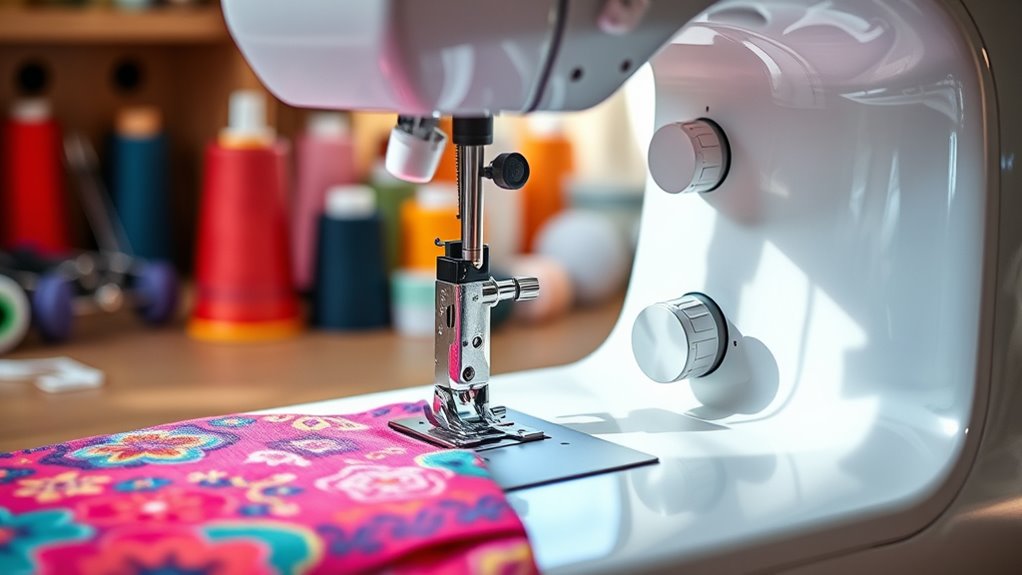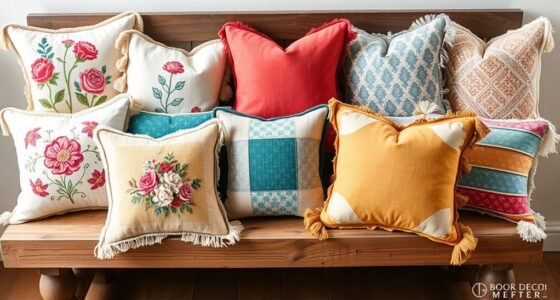To choose the right sewing machine, first identify your projects and fabric types to determine necessary features. Consider your skill level and budget to pick from mechanical, electronic, or computerized models that suit your needs. Focus on easy-to-use controls, stitch options, and durability. Don’t forget to test different machines and check reviews for reliability. Keep these tips in mind, and you’ll find the best fit for your sewing journey. Continue exploring for more helpful guidance.
Key Takeaways
- Assess your sewing projects, fabric types, and skill level to identify necessary features and machine complexity.
- Determine your budget and consider long-term needs to balance cost with desired features and durability.
- Choose a machine with user-friendly controls, adjustable stitch options, and essential functions suited to your skill.
- Research reputable brands offering good support, warranties, and reliable performance for long-term satisfaction.
- Set up a dedicated, well-lit workspace and follow maintenance tips to ensure your sewing machine’s longevity.
Understanding Different Types of Sewing Machines

When choosing a sewing machine, understanding the different types available can help you find the perfect fit for your projects. There are mainly three types: mechanical, electronic, and computerized.
Mechanical machines are straightforward, with manual controls, making them ideal for beginners or those who prefer simple operation.
Mechanical sewing machines feature manual controls, perfect for beginners or simple sewing tasks.
Electronic machines add features like adjustable stitch length and width, offering more versatility while still being easy to use.
Computerized machines take it further by providing automatic stitching options, built-in patterns, and advanced functions, perfect if you want more creativity and convenience.
Each type varies in complexity, price, and features. Knowing these differences helps you decide which machine suits your skill level and project needs, ensuring you get the best value and experience for your sewing endeavors.
Assessing Your Sewing Needs and Projects

Before choosing a sewing machine, you need to clearly identify your sewing needs and the types of projects you plan to undertake. Are you interested in basic hemming, quilting, or creating detailed garments? Think about the fabrics you’ll work with most often—delicate silks or heavy denim—and whether you’ll need specific features like embroidery or multiple stitch options. Consider your skill level as well; beginners may prefer simple models, while experienced sewists might want advanced capabilities. Assess how often you’ll sew and the scope of your projects to determine if you need a machine suitable for frequent use or occasional projects. Clarifying these needs helps you focus on machines that match your project scope, ensuring you choose one that supports your creativity and growth. Additionally, exploring performance features like multiple stitch options and durability can help you select a machine that will meet your long-term sewing ambitions. Understanding the contrast ratio of a machine’s features can also aid in selecting a model that provides consistent and high-quality results over time. Being aware of the cybersecurity vulnerabilities associated with digital sewing machines that connect to the internet may help you make safer choices. Moreover, considering performance tuning aspects such as motor power and maintenance requirements can extend the lifespan and reliability of your sewing machine. Incorporating remote diagnostics offered by some modern models can further optimize your sewing experience by identifying issues early and reducing downtime.
Key Features to Consider in a Sewing Machine
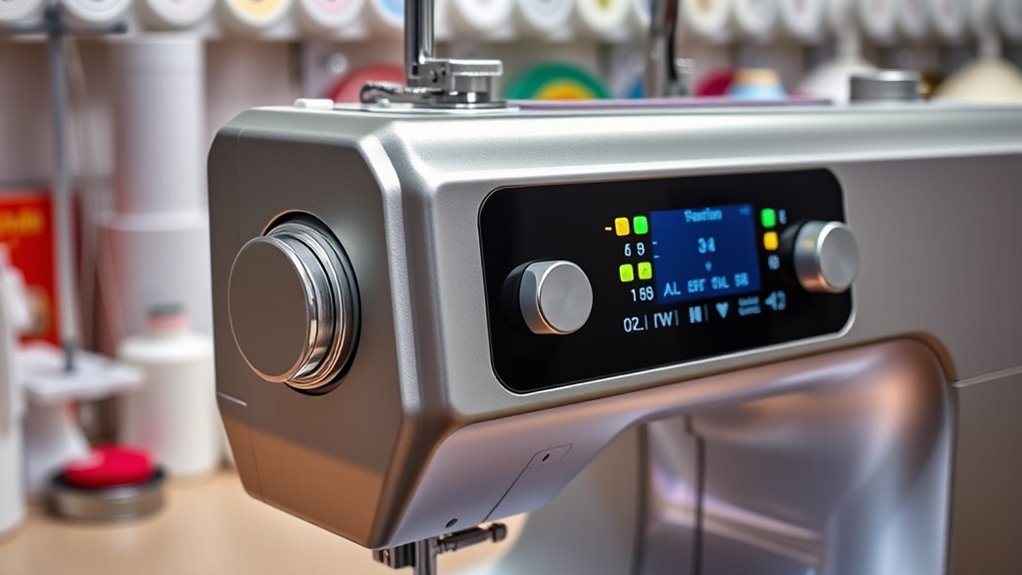
When choosing a sewing machine, you’ll want to take into account its stitching capabilities and the variety of stitch types it offers. Built-in features and functions can make your projects easier and more efficient. Familiarity with testing methodologies can help you evaluate a machine’s performance and durability before purchase. Additionally, understanding software quality assurance principles can assist in assessing the machine’s reliability and quality control measures. Intuitive controls help you operate the machine confidently. Focusing on these key features ensures you select a machine that matches your sewing needs and skill level, and considering performance testing can provide insights into the machine’s long-term durability and efficiency. Recognizing the significance of dream symbols in subconscious expression can also offer a unique perspective on your personal connection to the tools and materials you work with. Proper maintenance and regular repairs are essential to ensure your sewing machine functions optimally over time.
Stitching Capabilities and Types
Understanding a sewing machine’s stitching capabilities is essential because they directly influence the types of projects you can complete. Different machines offer various stitch patterns, such as straight, zigzag, or decorative stitches, which expand your creative options.
Consider whether you need basic stitches for simple projects or a wider selection for complex designs. Some machines allow adjustable stitch length and width, giving you more control over your sewing.
If you plan to do embroidery or decorative work, look for machines with specialized stitch options. Also, check if the machine supports multiple stitch modes or automatic functions, which can save time and effort.
Choosing a machine with the right stitching capabilities ensures it meets your current needs and allows room for growth in your sewing skills.
Built-in Features and Functions
Built-in features and functions can substantially enhance your sewing experience by making your projects easier and more efficient. Look for machines with adjustable stitch length and width, which give you greater control over your designs.
Automatic needle threaders save time and frustration, especially if you struggle with threading needles manually. A variety of built-in stitches, such as decorative, stretch, or quilting stitches, expand your creative options without needing extra attachments.
Some machines include features like a top drop-in bobbin for easy threading or a built-in buttonhole maker for professional finishes. These features streamline your workflow and help you achieve precise results.
Choosing a machine with the right combination of built-in functions ensures you can handle a wide range of sewing projects comfortably.
Ease of Use and Controls
Ease of use and controls are essential factors that can make or break your sewing experience. When choosing a machine, look for intuitive controls that are easy to understand and operate. Features like a clear stitch selector, accessible tension adjustments, and straightforward bobbin loading can save you time and frustration. A user-friendly interface is also important, including simple buttons or dials instead of complex menus. A clear, well-lit display can also help you quickly adjust settings. Additionally, check if the machine has features like a start/stop button for added convenience. These controls should feel natural and accessible, helping you focus on sewing rather than fighting with the machine. Incorporating modern safety features, such as automatic shut-off or finger guards, can further improve ease of use and peace of mind. Moreover, choosing a machine with adjustable speed controls can accommodate beginners and experienced users alike, making sewing more flexible and comfortable. Ensuring the controls are designed with intuitive operation in mind can significantly enhance your overall sewing experience and reduce the learning curve. Simplified control mechanisms enhance the overall user experience and reduce learning curves, making sewing smoother and more enjoyable.
Setting a Budget for Your Sewing Machine Purchase

Setting a budget is a crucial step in choosing the right sewing machine, as it helps narrow down your options and guarantees you don’t overspend. Determine how much you’re willing to invest before you start shopping. This keeps you focused and prevents impulse buys. Additionally, understanding air purifier maintenance can help you select a machine with features that are easy to maintain over time. Keep in mind that more expensive models often offer advanced features, durability, and versatility, but they aren’t always necessary for beginners or casual users. If you’re just starting out, a budget-friendly machine can meet your needs while saving money. Consider your long-term plans—if you see yourself sewing regularly or tackling complex projects, investing a bit more might be worthwhile. Setting a clear budget ensures you find a machine that fits your financial situation without sacrificing quality or functionality. Being aware of precious metals dealer reviews can also provide insights into the reliability of brands and models within your price range. Additionally, researching consumer reviews can provide real-world insights into the reliability and performance of various models within your budget. Recognizing the importance of narcissistic traits in evaluating customer feedback can help you identify honest opinions and avoid manipulation or overly biased reviews.
Evaluating Ease of Use and User-Friendliness
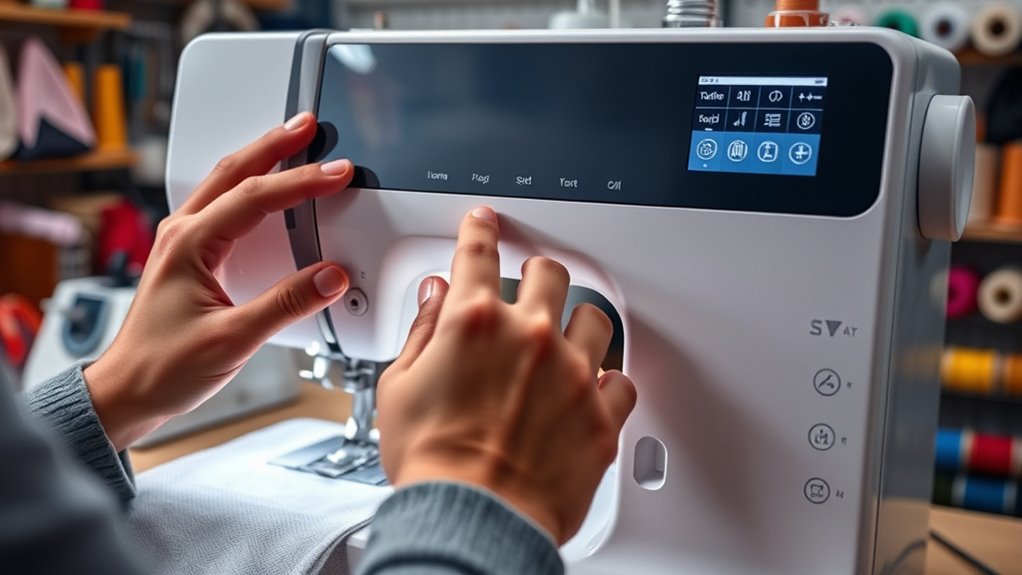
When choosing a sewing machine, you’ll want to focus on how easy it’s to operate. Look for an intuitive control panel, a simple threading process, and a clear instruction manual that guides you through setup and troubleshooting. Additionally, verifying compatibility with accessories like headphones can enhance your sewing experience by providing better audio feedback during use. These features can make sewing more enjoyable and help you build confidence quickly. Also, considering features that promote user-friendliness, such as adjustable stitch length and speed controls, can further simplify your sewing projects. Incorporating models with easy-to-navigate controls can further reduce frustration and streamline your sewing process.
Intuitive Control Panel
An intuitive control panel can make or break your sewing experience, especially if you’re new to machines or prefer straightforward operation. When evaluating models, look for a layout that’s easy to understand, with clear labels and minimal buttons.
A good control panel should allow you to switch stitches quickly without confusion. Features like a digital display or touch screen can simplify selecting settings and adjusting stitch length or width.
Also, check if the controls are responsive and feel sturdy. Avoid machines with cluttered or complicated panels, as they can slow you down.
The right control panel helps you focus on sewing rather than struggling to figure out how to operate your machine. It makes your workflow smoother and more enjoyable, especially during longer projects.
Simple Threading Process
How easy is it to thread the machine? A simple threading process makes sewing more enjoyable and less frustrating. Look for a machine with clearly marked guides and minimal steps. Some models have automatic needle threaders that save you time and effort, especially if your eyesight isn’t perfect.
Others require manual threading, but if it’s straightforward with clear instructions, that’s still manageable. Check whether the threading path is smooth and unobstructed, reducing the chance of mistakes.
A machine with a user-friendly threading system ensures you spend less time fussing and more time sewing. Ultimately, the easier it’s to thread, the more confident you’ll feel tackling various projects.
Prioritize models known for their simple, hassle-free threading process to enhance your overall sewing experience.
Clear Instruction Manual
A clear and well-organized instruction manual is essential for making your sewing machine easy to use. It helps you understand setup, troubleshooting, and maintenance quickly, saving time and frustration.
When evaluating manuals, look for step-by-step guidance with diagrams or photos. An intuitive manual should also include troubleshooting tips, clear symbols, and language that’s easy to follow.
- Clear diagrams showing threading and bobbin setup
- Step-by-step instructions for basic functions
- Troubleshooting section for common issues
- Symbols explained for quick understanding
- Maintenance and care guidelines included
A good manual makes your sewing experience smoother, letting you focus on creating rather than figuring out how your machine works.
Choose a model with a user-friendly manual to ensure confident, enjoyable sewing.
Considering Machine Durability and Reliability
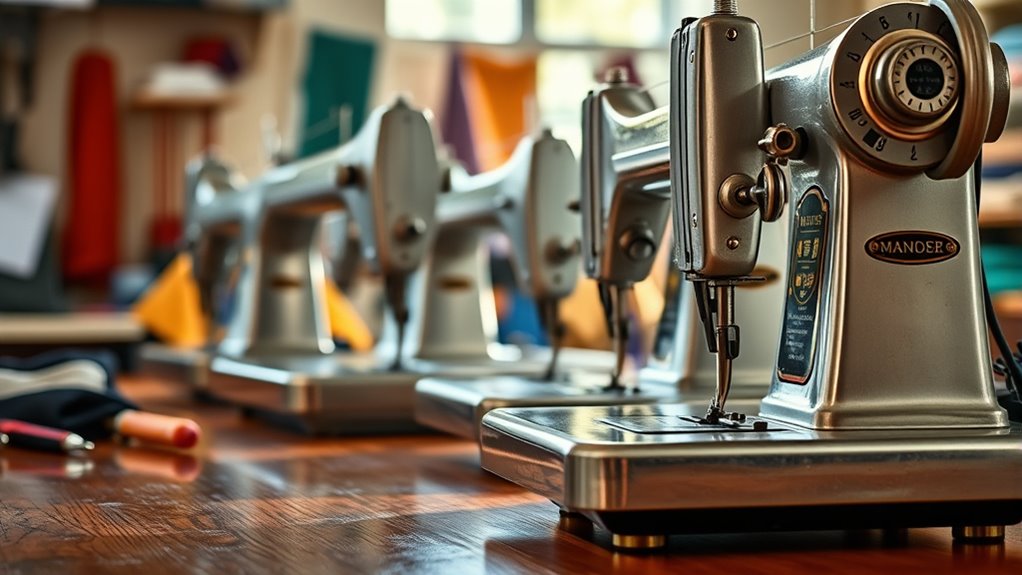
When choosing a sewing machine, you can’t overlook its durability and reliability, as these factors determine how well the machine will perform over time. A sturdy machine made with quality materials will withstand frequent use and resist wear and tear.
Look for features like metal internal parts, which tend to last longer than plastic ones. Check reviews and user feedback to gauge how often machines break down or require repairs.
Opt for sewing machines with metal internal parts for greater longevity and durability.
Reliable machines maintain consistent stitching and handle various fabrics without jamming or skipping stitches. Consider the brand’s reputation for producing durable products, and avoid models with a history of mechanical issues.
Investing in a durable, reliable machine saves you money and frustration in the long run, ensuring your sewing projects stay smooth and enjoyable.
Exploring Brands and Customer Support Options
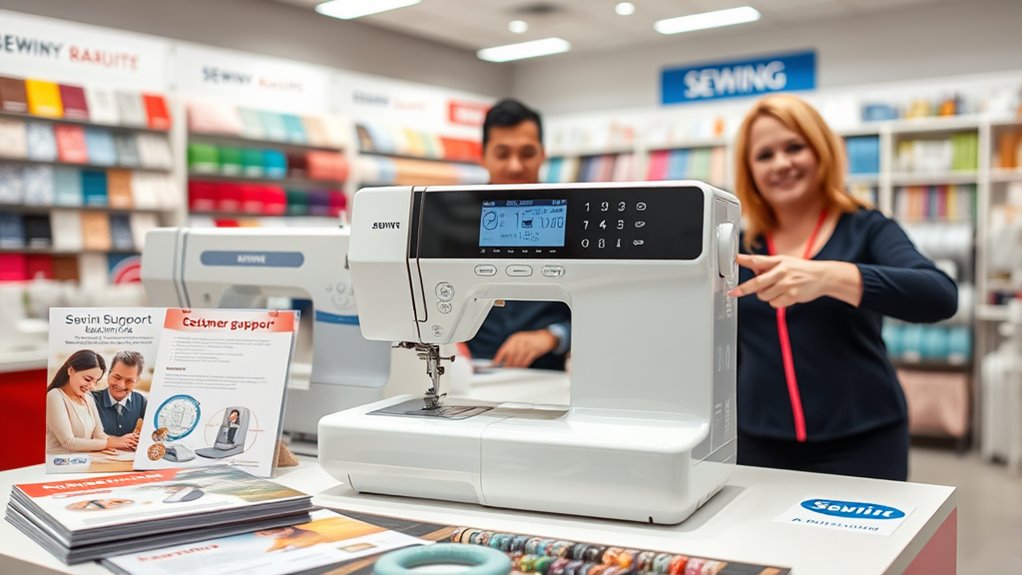
Choosing a sewing machine involves more than just its features; it also means considering the brands behind them and the support they offer. Reputable brands often provide better quality, innovation, and durability, making your investment worthwhile.
Additionally, strong customer support can save you time and frustration if issues arise. Look for brands with a proven track record and positive reviews from other users.
Consider their warranty policies, repair services, and availability of replacement parts. Reliable support means you can get help quickly and keep your machine running smoothly.
- Well-known brand reputation and history
- Availability of authorized service centers
- Responsive customer service and technical support
- Clear warranty and repair policies
- Access to user manuals and online resources
Testing Machines Before Making a Decision
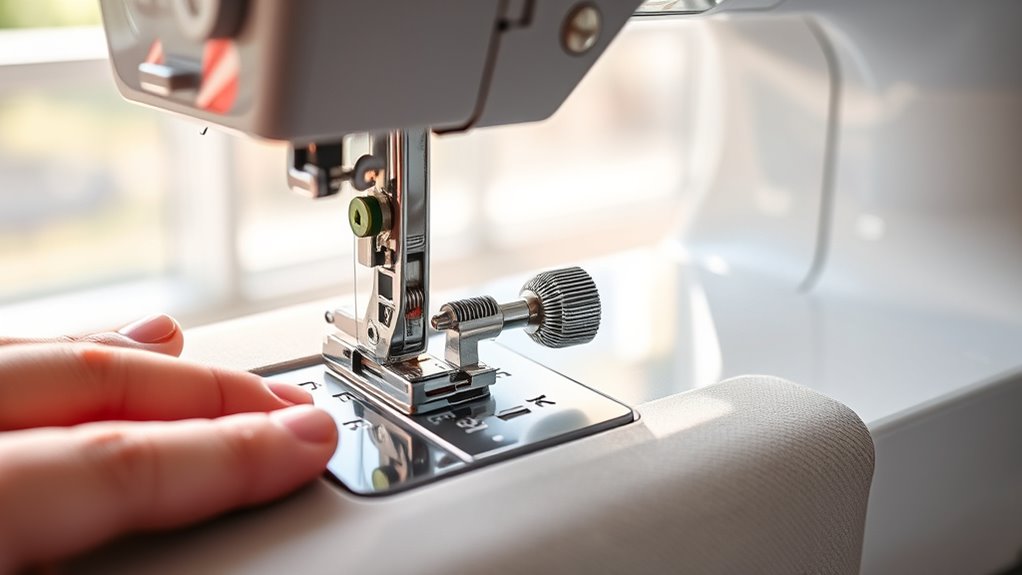
Testing sewing machines in person is essential to guarantee they meet your needs and feel comfortable to operate. When you try out different models, pay attention to how easy it’s to navigate the controls and whether the machine runs smoothly.
Check the stitch quality on scrap fabric, ensuring it’s even and consistent. Handle the machine to see if it’s lightweight enough for you to carry or if it feels sturdy and durable.
Test the speed control and other features you plan to use frequently. Don’t rush; take your time to see how intuitive it’s to switch between stitches and adjust settings.
Making the Final Purchase and Getting Started
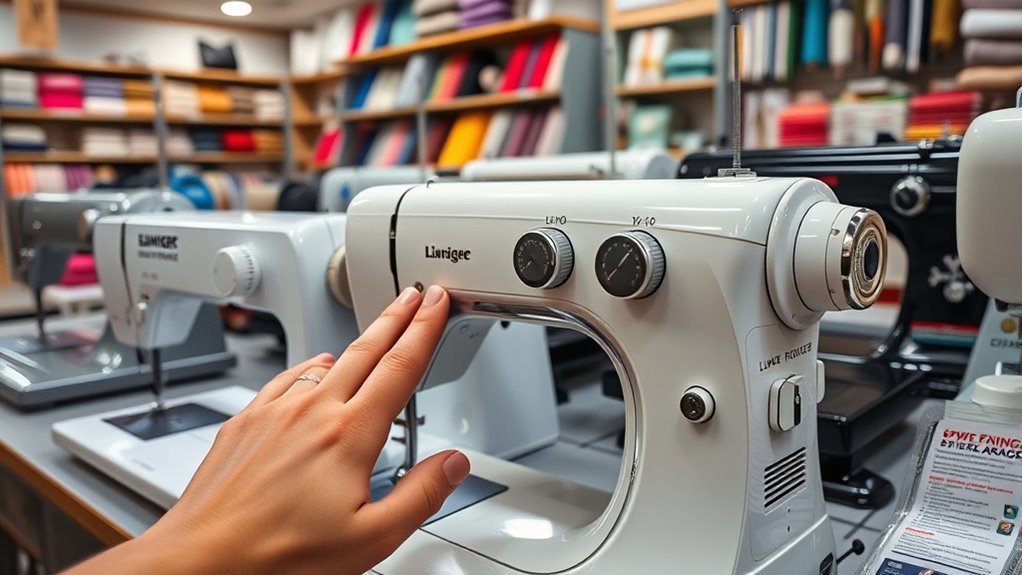
Once you’ve found a sewing machine that feels comfortable and performs well during your testing, it’s time to make your final purchase. Before you buy, double-check that it has the features you need and fits your budget. Consider purchasing from a reputable store with good customer service and warranty options.
Once you have your machine home, read the manual thoroughly to understand its functions. Set up a simple workspace with good lighting and essential supplies. Start with basic stitches to get comfortable, then gradually explore more complex projects.
After bringing your machine home, read the manual carefully and set up a cozy workspace to start sewing confidently.
Remember to keep your machine clean and well-oiled for smooth operation. Regular maintenance ensures your machine lasts longer, making sewing enjoyable and stress-free.
- Verify warranty and return policies
- Gather essential sewing supplies
- Read the manual carefully
- Set up a comfortable workspace
- Practice basic stitches first
Frequently Asked Questions
Can I Upgrade My Sewing Machine Later?
You can definitely upgrade your sewing machine later. As you gain experience and your needs evolve, it’s common to move to more advanced models with better features.
Keep in mind, upgrading might involve selling or trading in your current machine. Research your options first, consider your budget, and choose a model that suits your new skill level and projects.
Upgrading helps you grow as a sewer without feeling limited by your first machine.
How Much Maintenance Does a Sewing Machine Require?
You ask about sewing machine maintenance. Regular upkeep keeps your machine running smoothly.
You’ll need to clean lint from the bobbin case and feed dogs, oil moving parts as recommended, and change needles frequently.
Also, check the tension and guarantee the machine is stored in a dry, dust-free space.
With proper care, your sewing machine will last longer and perform better, making your sewing projects more enjoyable.
Are There Sewing Machines Suitable for Children?
You’re wondering if there are sewing machines perfect for kids? Absolutely! Some machines are like tiny superheroes, built just for little hands and big imaginations. They’re super easy to use, with colorful designs and safety features that make sewing feel like a magical adventure.
These machines turn kids into sewing superheroes, helping them learn and create while having a blast. It’s the perfect way to spark their creativity early on!
What Safety Features Should I Look For?
When choosing a sewing machine, safety features are essential. Look for machines with automatic shut-off to prevent accidents, especially if kids use it.
Make certain there’s a finger guard to protect fingers from the needle, and choose models with sturdy, non-slip bases for stability.
A clear, easy-to-reach stop button also helps you quickly halt sewing if needed.
Prioritize these features to keep your sewing safe and worry-free.
How Do I Troubleshoot Common Sewing Machine Problems?
Ever faced a sewing machine that suddenly jams or skips stitches? Don’t panic! First, check your needle; a bent or dull needle can cause issues.
Next, make sure your bobbin is correctly placed and wound properly. Clean any lint or debris from the bobbin case and feed dogs.
If problems persist, rethread your machine, making certain the thread’s tension is correct.
With patience, you’ll keep your sewing projects on track.
Conclusion
Choosing the right sewing machine can be a game-changer for your projects. Did you know that over 60% of new sewists say ease of use influences their choice the most? By understanding your needs, testing different models, and considering features and brands, you’ll find the perfect match. Remember, investing a little time now guarantees you enjoy sewing for years to come. Happy stitching!
